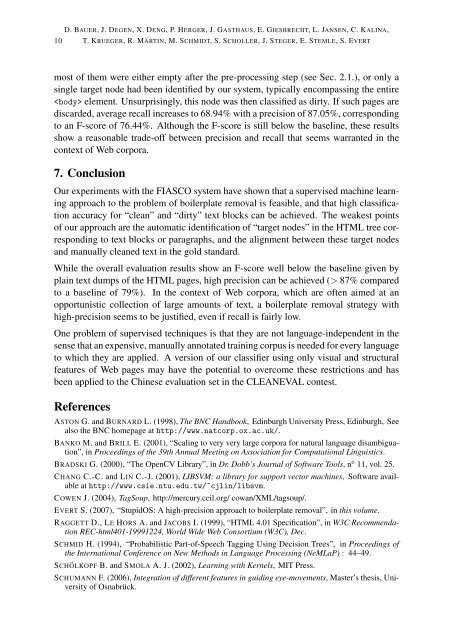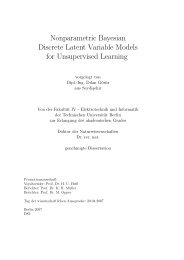FIASCO: Filtering the Internet by Automatic Subtree Classification ...
FIASCO: Filtering the Internet by Automatic Subtree Classification ...
FIASCO: Filtering the Internet by Automatic Subtree Classification ...
You also want an ePaper? Increase the reach of your titles
YUMPU automatically turns print PDFs into web optimized ePapers that Google loves.
D. BAUER, J. DEGEN, X. DENG, P. HERGER, J. GASTHAUS, E. GIESBRECHT, L. JANSEN, C. KALINA,<br />
10 T. KRUEGER, R. MÄRTIN, M. SCHMIDT, S. SCHOLLER, J. STEGER, E. STEMLE, S. EVERT<br />
most of <strong>the</strong>m were ei<strong>the</strong>r empty after <strong>the</strong> pre-processing step (see Sec. 2.1.), or only a<br />
single target node had been identified <strong>by</strong> our system, typically encompassing <strong>the</strong> entire<br />
element. Unsurprisingly, this node was <strong>the</strong>n classified as dirty. If such pages are<br />
discarded, average recall increases to 68.94% with a precision of 87.05%, corresponding<br />
to an F-score of 76.44%. Although <strong>the</strong> F-score is still below <strong>the</strong> baseline, <strong>the</strong>se results<br />
show a reasonable trade-off between precision and recall that seems warranted in <strong>the</strong><br />
context of Web corpora.<br />
7. Conclusion<br />
Our experiments with <strong>the</strong> <strong>FIASCO</strong> system have shown that a supervised machine learning<br />
approach to <strong>the</strong> problem of boilerplate removal is feasible, and that high classification<br />
accuracy for “clean” and “dirty” text blocks can be achieved. The weakest points<br />
of our approach are <strong>the</strong> automatic identification of “target nodes” in <strong>the</strong> HTML tree corresponding<br />
to text blocks or paragraphs, and <strong>the</strong> alignment between <strong>the</strong>se target nodes<br />
and manually cleaned text in <strong>the</strong> gold standard.<br />
While <strong>the</strong> overall evaluation results show an F-score well below <strong>the</strong> baseline given <strong>by</strong><br />
plain text dumps of <strong>the</strong> HTML pages, high precision can be achieved (> 87% compared<br />
to a baseline of 79%). In <strong>the</strong> context of Web corpora, which are often aimed at an<br />
opportunistic collection of large amounts of text, a boilerplate removal strategy with<br />
high-precision seems to be justified, even if recall is fairly low.<br />
One problem of supervised techniques is that <strong>the</strong>y are not language-independent in <strong>the</strong><br />
sense that an expensive, manually annotated training corpus is needed for every language<br />
to which <strong>the</strong>y are applied. A version of our classifier using only visual and structural<br />
features of Web pages may have <strong>the</strong> potential to overcome <strong>the</strong>se restrictions and has<br />
been applied to <strong>the</strong> Chinese evaluation set in <strong>the</strong> CLEANEVAL contest.<br />
References<br />
ASTON G. and BURNARD L. (1998), The BNC Handbook, Edinburgh University Press, Edinburgh, See<br />
also <strong>the</strong> BNC homepage at http://www.natcorp.ox.ac.uk/.<br />
BANKO M. and BRILL E. (2001), “Scaling to very very large corpora for natural language disambiguation”,<br />
in Proceedings of <strong>the</strong> 39th Annual Meeting on Association for Computational Linguistics.<br />
BRADSKI G. (2000), “The OpenCV Library”, in Dr. Dobb’s Journal of Software Tools, n o 11, vol. 25.<br />
CHANG C.-C. and LIN C.-J. (2001), LIBSVM: a library for support vector machines, Software available<br />
at http://www.csie.ntu.edu.tw/~cjlin/libsvm.<br />
COWEN J. (2004), TagSoup, http://mercury.ccil.org/ cowan/XML/tagsoup/.<br />
EVERT S. (2007), “StupidOS: A high-precision approach to boilerplate removal”, in this volume.<br />
RAGGETT D., LE HORS A. and JACOBS I. (1999), “HTML 4.01 Specification”, in W3C Recommendation<br />
REC-html401-19991224, World Wide Web Consortium (W3C), Dec.<br />
SCHMID H. (1994), “Probabilistic Part-of-Speech Tagging Using Decision Trees”, in Proceedings of<br />
<strong>the</strong> International Conference on New Methods in Language Processing (NeMLaP) : 44–49.<br />
SCHÖLKOPF B. and SMOLA A. J. (2002), Learning with Kernels, MIT Press.<br />
SCHUMANN F. (2006), Integration of different features in guiding eye-movements, Master’s <strong>the</strong>sis, University<br />
of Osnabrück.

















